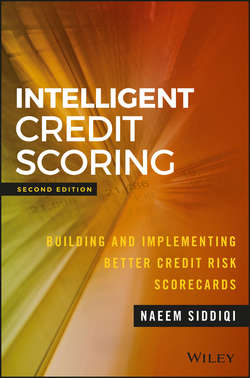Читать книгу Intelligent Credit Scoring - Siddiqi Naeem - Страница 9
На сайте Литреса книга снята с продажи.
Chapter 2
Scorecard Development: The People and the Process
Оглавление“Talent wins games, but teamwork and intelligence wins championships.”
– Michael Jordan
Many years ago, I developed a set of scorecards for a risk management department of a bank. The data sent to us by the risk folks was great, and we built a good scorecard with about 14 reasonable variables. About two weeks after delivering the scorecard, we got a call from the customer. Apparently, two of the variables that they had sent to us in the data set were not usable, and we needed to take them out. I have had bankers tell me stories of changing scorecard variables because information technology (IT) gave them estimates of three to four months to code up a new derived variable. IT folks, however, tell me they hate to be surprised by last-minute requests to implement new scorecards or new derived variables that cannot be handled by their systems. Almost every bank I’ve advised has had occasions where the variables desired/expected by the risk manager could not be in models, where models built could not be used because other stakeholders would not agree to them, or where other surprises lay waiting months after the actual work was done.
These are some of the things that cause problems during scorecard development and implementation projects. In order to prevent such problems, the process of scorecard development needs to be a collaborative one between IT, risk management (strategy and policy), modeling, validation, and operational staff. This collaboration not only creates better scorecards, it also ensures that the solutions are consistent with business direction, prevent surprises, and enable education and knowledge transfer during the development process. Scorecard development is not a “black box” process and should not be treated as such. Experience has shown that developing scorecards in isolation can lead to problems such as inclusion of characteristics that are no longer collected, legally suspect, or difficult to collect operationally, exclusion of operationally critical variables, and devising of strategies that result in “surprises” or are unimplementable. In fact, since the credit crisis of 2007–2008, the tolerance at most banks for complex/black box models and processes is gone. The business user expects a model that can be understood, justified, and where necessary, be tweaked based on business considerations, as well as an open and transparent process that can be controlled.
In this chapter, we will look at the various personas that should be involved in a scorecard development and implementation project. The level of involvement of staff members varies, and different staff members are required at various key stages of the process. By understanding the types of resources required for a successful scorecard development and implementation project, one will also start to appreciate the business and operational considerations that go into such projects.
